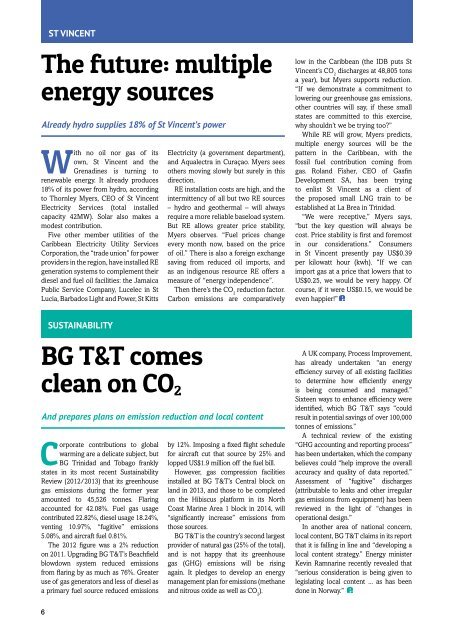ENERGY Caribbean newsletter (April 2014 • Issue no. 72)
The final edition of the ENERGY Caribbean newsletter
The final edition of the ENERGY Caribbean newsletter
- No tags were found...
Create successful ePaper yourself
Turn your PDF publications into a flip-book with our unique Google optimized e-Paper software.
ST VINCENT<br />
The future: multiple<br />
energy sources<br />
Already hydro supplies 18% of St Vincent’s power<br />
With <strong>no</strong> oil <strong>no</strong>r gas of its<br />
own, St Vincent and the<br />
Grenadines is turning to<br />
renewable energy. It already produces<br />
18% of its power from hydro, according<br />
to Thornley Myers, CEO of St Vincent<br />
Electricity Services (total installed<br />
capacity 42MW). Solar also makes a<br />
modest contribution.<br />
Five other member utilities of the<br />
<strong>Caribbean</strong> Electricity Utility Services<br />
Corporation, the “trade union” for power<br />
providers in the region, have installed RE<br />
generation systems to complement their<br />
diesel and fuel oil facilities: the Jamaica<br />
Public Service Company, Lucelec in St<br />
Lucia, Barbados Light and Power, St Kitts<br />
Electricity (a government department),<br />
and Aqualectra in Curaçao. Myers sees<br />
others moving slowly but surely in this<br />
direction.<br />
RE installation costs are high, and the<br />
intermittency of all but two RE sources<br />
– hydro and geothermal – will always<br />
require a more reliable baseload system.<br />
But RE allows greater price stability,<br />
Myers observes. “Fuel prices change<br />
every month <strong>no</strong>w, based on the price<br />
of oil.” There is also a foreign exchange<br />
saving from reduced oil imports, and<br />
as an indige<strong>no</strong>us resource RE offers a<br />
measure of “energy independence”.<br />
Then there’s the CO 2<br />
reduction factor.<br />
Carbon emissions are comparatively<br />
low in the <strong>Caribbean</strong> (the IDB puts St<br />
Vincent’s CO 2<br />
discharges at 48,805 tons<br />
a year), but Myers supports reduction.<br />
“If we demonstrate a commitment to<br />
lowering our greenhouse gas emissions,<br />
other countries will say, if these small<br />
states are committed to this exercise,<br />
why shouldn’t we be trying too?”<br />
While RE will grow, Myers predicts,<br />
multiple energy sources will be the<br />
pattern in the <strong>Caribbean</strong>, with the<br />
fossil fuel contribution coming from<br />
gas. Roland Fisher, CEO of Gasfin<br />
Development SA, has been trying<br />
to enlist St Vincent as a client of<br />
the proposed small LNG train to be<br />
established at La Brea in Trinidad.<br />
“We were receptive,” Myers says,<br />
“but the key question will always be<br />
cost. Price stability is first and foremost<br />
in our considerations.” Consumers<br />
in St Vincent presently pay US$0.39<br />
per kilowatt hour (kwh). “If we can<br />
import gas at a price that lowers that to<br />
US$0.25, we would be very happy. Of<br />
course, if it were US$0.15, we would be<br />
even happier!”<br />
SUSTAINABILITY<br />
BG T&T comes<br />
clean on CO 2<br />
And prepares plans on emission reduction and local content<br />
Corporate contributions to global<br />
warming are a delicate subject, but<br />
BG Trinidad and Tobago frankly<br />
states in its most recent Sustainability<br />
Review (2012/2013) that its greenhouse<br />
gas emissions during the former year<br />
amounted to 45,526 tonnes. Flaring<br />
accounted for 42.08%. Fuel gas usage<br />
contributed 22.82%, diesel usage 18.24%,<br />
venting 10.97%, “fugitive” emissions<br />
5.08%, and aircraft fuel 0.81%.<br />
The 2012 figure was a 2% reduction<br />
on 2011. Upgrading BG T&T’s Beachfield<br />
blowdown system reduced emissions<br />
from flaring by as much as 76%. Greater<br />
use of gas generators and less of diesel as<br />
a primary fuel source reduced emissions<br />
by 12%. Imposing a fixed flight schedule<br />
for aircraft cut that source by 25% and<br />
lopped US$1.9 million off the fuel bill.<br />
However, gas compression facilities<br />
installed at BG T&T’s Central block on<br />
land in 2013, and those to be completed<br />
on the Hibiscus platform in its North<br />
Coast Marine Area 1 block in <strong>2014</strong>, will<br />
“significantly increase” emissions from<br />
those sources.<br />
BG T&T is the country’s second largest<br />
provider of natural gas (25% of the total),<br />
and is <strong>no</strong>t happy that its greenhouse<br />
gas (GHG) emissions will be rising<br />
again. It pledges to develop an energy<br />
management plan for emissions (methane<br />
and nitrous oxide as well as CO 2<br />
).<br />
A UK company, Process Improvement,<br />
has already undertaken “an energy<br />
efficiency survey of all existing facilities<br />
to determine how efficiently energy<br />
is being consumed and managed.”<br />
Sixteen ways to enhance efficiency were<br />
identified, which BG T&T says “could<br />
result in potential savings of over 100,000<br />
tonnes of emissions.”<br />
A technical review of the existing<br />
“GHG accounting and reporting process”<br />
has been undertaken, which the company<br />
believes could “help improve the overall<br />
accuracy and quality of data reported.”<br />
Assessment of “fugitive” discharges<br />
(attributable to leaks and other irregular<br />
gas emissions from equipment) has been<br />
reviewed in the light of “changes in<br />
operational design.”<br />
In a<strong>no</strong>ther area of national concern,<br />
local content, BG T&T claims in its report<br />
that it is falling in line and “developing a<br />
local content strategy.” Energy minister<br />
Kevin Ramnarine recently revealed that<br />
“serious consideration is being given to<br />
legislating local content ... as has been<br />
done in Norway.”<br />
6


















